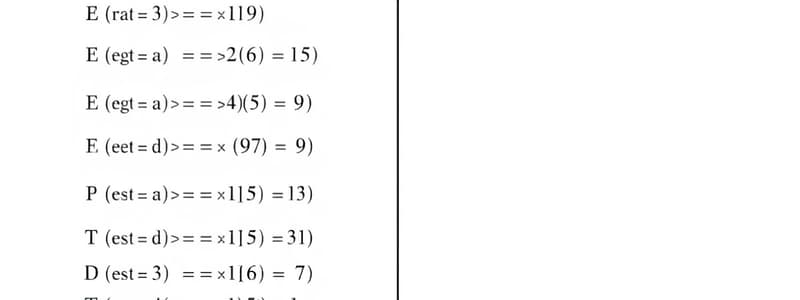Podcast
Questions and Answers
What is an argument?
What is an argument?
- A conclusion
- A sequence of statements that end with a conclusion (correct)
- An incorrect reasoning
- None of the above
What does it mean for a conclusion to be valid?
What does it mean for a conclusion to be valid?
A conclusion that must follow the truth of the preceding statements.
What are premises in an argument?
What are premises in an argument?
Proceeding statements.
What are fallacies?
What are fallacies?
What are rules of inference?
What are rules of inference?
What is the Law of Detachment?
What is the Law of Detachment?
Match the logical forms with their descriptions:
Match the logical forms with their descriptions:
Flashcards
What is an argument?
What is an argument?
A sequence of statements that end with a conclusion.
What is a valid conclusion?
What is a valid conclusion?
A conclusion that inevitably follows if the preceding statements are true.
Premises in arguments?
Premises in arguments?
Statements that precede and support the conclusion.
What are fallacies?
What are fallacies?
Signup and view all the flashcards
Rules of inference?
Rules of inference?
Signup and view all the flashcards
Law of Detachment?
Law of Detachment?
Signup and view all the flashcards
Study Notes
Argument Fundamentals
- An argument consists of a sequence of statements culminating in a conclusion.
- Validity indicates that a conclusion necessarily follows from its preceding statements.
Key Components of Arguments
- Premises are the preceding statements that support the conclusion.
- Fallacies represent incorrect reasoning that undermines an argument's validity.
Rules of Inference
- Rules of inference are basic argument structures that allow for the derivation of valid conclusions from given premises.
Specific Rules of Inference
-
Law of Detachment (Modus Ponens): If "p" is true and "p → q" is true, then "q" is necessarily true.
-
Example structure: If "p" and "p → q", then conclude "q".
-
Modus Tollens: If "¬q" (not q) is true and "p → q" is true, then "¬p" (not p) must also be true.
-
Example structure: If "¬q" and "p → q", then conclude "¬p".
-
Hypothetical Syllogism: If "p → q" and "q → r" are both true, then "p → r" is also true.
-
Example structure: If "p → q" and "q → r", then conclude "p → r".
-
Disjunctive Syllogism: From "p ∨ q" (either p or q) and "¬p" (not p), we can conclude "q".
-
Example structure: If "p ∨ q" and "¬p", then conclude "q".
-
Addition: If "p" is true, we can conclude "p ∨ q" (p or q).
-
Example structure: If "p", then conclude "p ∨ q".
-
Simplification: If "p ∧ q" (both p and q) is true, we can conclude "p".
-
Example structure: If "p ∧ q", then conclude "p".
-
Conjunction: If both "p" and "q" are true, we can form "p ∧ q".
-
Example structure: If "p" and "q", then conclude "p ∧ q".
-
Resolution: From "p ∨ q" and "¬p ∨ r", we can conclude "q ∨ r".
-
Example structure: If "p ∨ q" and "¬p ∨ r", then conclude "q ∨ r".
Studying That Suits You
Use AI to generate personalized quizzes and flashcards to suit your learning preferences.



